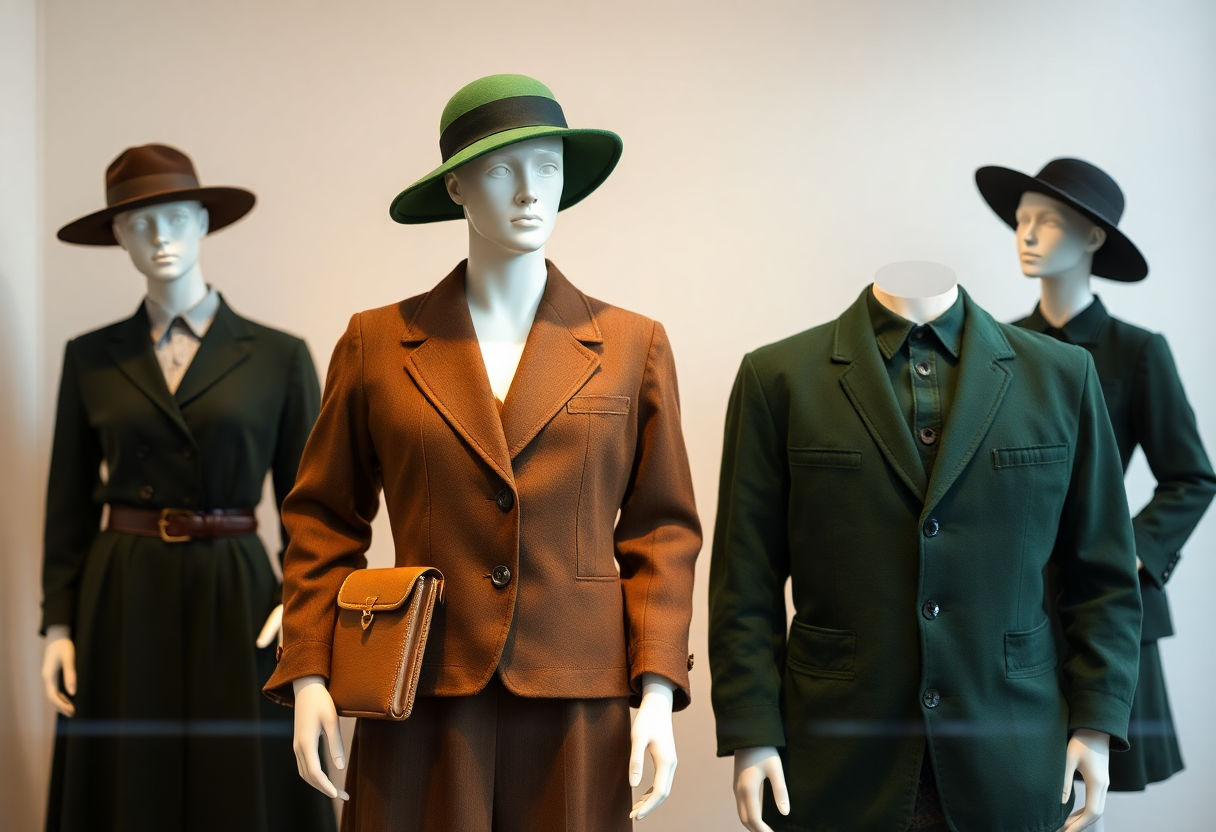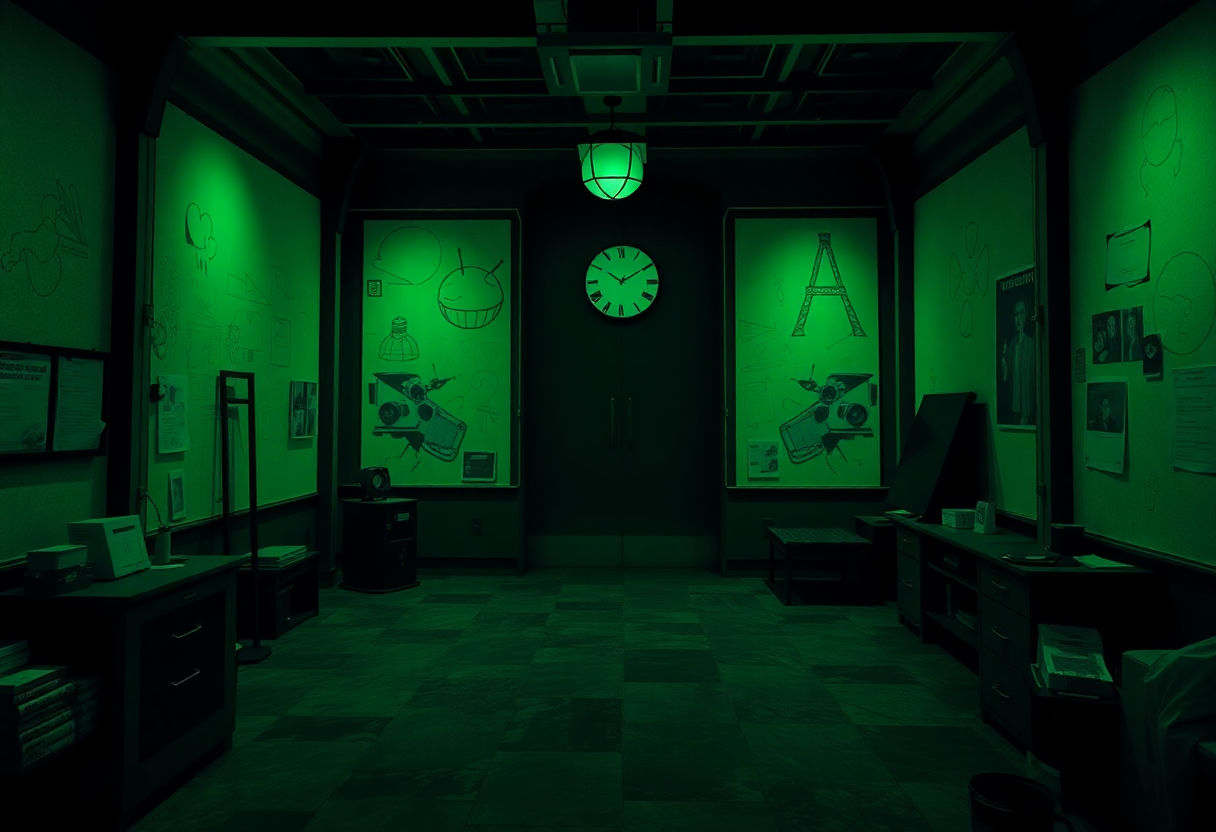In the realm of Dark Academia, the color green emerges as a compelling narrative thread, weaving through literature, fashion, and philosophy to enrich the aesthetic’s intellectual depth. Imbued with profound symbolism—from life and renewal to introspection—green adds texture and layers to this evocative cultural phenomenon. Its historical significance and psychological impact underscore its versatile use, creating a harmonious blend of elegance and mystique. This exploration invites you to delve deeper into how green not only transforms personal style but also decorum within Dark Academia spaces, offering a fresh lens to appreciate its enduring allure.
Key Takeaways
- The color green is central to Dark Academia, symbolizing renewal, learning, and introspection, which enriches its aesthetic narrative.
- Green’s literary and philosophical roots add depth, as it has historically represented knowledge and scholarly pursuits.
- In fashion, green adds elegance and individuality, aligning with Dark Academia’s sophisticated yet personal style.
- Interior design in Dark Academia utilizes green hues to create spaces that are intellectually stimulating and visually calming.
- Integrating green into personal style offers a unique blend of historical relevance and modern interpretation, enhancing the overall aesthetic experience.
The Color Symbolism of Green
Green, a hue deeply woven into the fabric of the Dark Academia aesthetic, embodies a rich tapestry of symbolism. This color’s significance transcends mere visual appeal, acting as a complex symbol of life, renewal, and growth. Within the context of Dark Academia, green resonates with themes of nature and intellectual metamorphosis, inviting an introspective journey through the labyrinth of knowledge and self-discovery.
Historically, green has been associated with learning and wisdom—aptly reflected in the verdant halls of academia, lush with ideas and innovation. This association can be traced back to ancient philosophies where green represented logic and intellectual growth, suggesting a harmonious balance between emotion and reason.
Green’s presence in the Dark Academia palette also extends to its connotations of mystery and introspection. As individuals seek understanding and purpose, green becomes a symbol for the intricate depths of the human psyche, encouraging a journey into the hidden recesses of one’s mind. It evokes a sense of peace and exploration, drawing parallels to verdant landscapes that invite contemplation and reflection.
Furthermore, green is emblematic of renewal and rebirth, reflecting the cyclical nature of knowledge acquisition and personal development. This aspect of renewal mirrors nature’s perennial cycle, inspiring those who embrace the Dark Academia aesthetic to continuously seek enlightenment and self-growth.
In essence, green’s symbolism within the Dark Academia context is multifaceted, providing a profound connection between the intellectual pursuits and the natural world, while inviting a deeper understanding of oneself and the enduring quest for knowledge.
Green in Literature and Philosophy
Green has long been imbued with a complex tapestry of meanings in both literature and philosophy, reflecting themes that resonate deeply with the Dark Academia aesthetic. In literature, green often symbolizes fertility, growth, and enigmatic allure. The subtle yet persistent presence of green in classic novels enriches the narrative with underlying implications of hope and melancholy. For instance, The Great Gatsby, with its iconic green light symbolizing both aspiration and unattainable desire, underscores the color’s dual nature as a beacon of both promise and despair.
Philosophically, green represents balance, a median between competing forces of life and decay, echoing the classical philosophical pursuit of harmony. This symbolic intersection finds expression in the works of existential philosophers, where green embodies a yearning for knowledge amidst the chaos of existence. In such frameworks, green becomes a metaphor for introspective journeys and the quest for meaning within the context of life’s transient nature.
Within Dark Academia, the appropriation of green serves to evoke a sense of nostalgia and intellectual curiosity. It invites the observer to contemplate themes of introspection and renewal against a backdrop of scholastic pursuit. The use of this color creates a bridge between the material and the metaphysical, reinforcing its philosophical undercurrents. Thus, green remains a poignant color in this subculture, nurturing a melancholic yet intellectually invigorating ambiance that encourages a deeper engagement with literature and philosophy.
The Green Aesthetic in Fashion

Green plays a transformative role in the fashion realm of the Dark Academia aesthetic, adding layers of nuanced elegance and richness to its somber undertones. Deeply entwined with the philosophical and intellectual ethos that defines the style, green imbues clothing with an aura of mystery and timeless sophistication.
Incorporating green into Dark Academia fashion often involves the use of various shades such as olive, emerald, and forest green. These hues are chosen for their ability to convey an earthy connection, merging intellectual pursuits with a sense of natural curiosity and exploration. Layering green fabrics—from luxurious velvet to rugged wool—creates a visually compelling and textured look that captures the essence of scholarly contemplation.
When selecting garments, individuals lean towards classic cuts with modern twists. Items such as green blazers, woolen cardigans, or pleated skirts become staples, allowing for versatile combinations that maintain individuality while staying true to the aesthetic’s core principles. Accessories, too, find their place in this narrative, with green leather belts, vintage sunglasses, and opulent brooches making subtle yet impactful statements.
Footwear in green further enriches the visual story. Brogues, ankle boots, or loafers in muted green tones can enhance an outfit, creating a seamless continuity with the rest of the attire. The overall goal is to achieve a seamless blend of tradition and innovation, where historical references meet contemporary expression.
Ultimately, the green aesthetic in Dark Academia fashion not only enhances personal expression but also symbolizes a deeper connection to the intellectual and natural worlds, reflecting an ongoing dialogue between the two.
Decor and Green Hues in Dark Academia Spaces

In crafting Dark Academia spaces, green hues play an instrumental role in enhancing the atmosphere. These shades resonate with the aesthetic’s penchant for nature, learning, and introspection, breathing life into dimly lit libraries or vintage-styled study rooms. The careful selection of green tones in decor can encapsulate the quiet elegance and mystery that define this style.
A common choice in Dark Academia spaces is deep emerald green, its rich depth lending an air of sophistication. This hue, when utilized on walls or prominent furniture, can create a serene environment conducive to study and contemplation. Pairing deeper greens with dark wood furnishings, leather-bound books, and aged metals further complements the aesthetic, adding texture and historical depth.
Subtle accents such as mossy green or olive tones are perfect for textiles and decorative items. Consider incorporating these through throw pillows, curtains, or old-world maps. Such details subtly invite the natural world indoors, creating a seamless blend of the organic and the intellectual.
Plants also serve as quintessential green elements in these settings. Not only do they provide a literal splash of life, but they also align with Dark Academia’s philosophical ties to nature. Select ivy, ferns, or pothos, which thrive in lower light and contribute to a contemplative atmosphere.
Ultimately, the intelligent use of green hues in a Dark Academia space enriches its essence, transforming it into a refuge that fosters both learning and reflection.
Historical Influence of Green
In the Dark Academia aesthetic, the color green carries a profound historical significance influenced by various eras and cultures. One of its earliest associations comes from the Victorian era, where green hues were frequently found in architectural designs and botanical gardens, symbolizing connections to nature and intellectual pursuits. This period saw the cultivation of private libraries often adorned in rich green tones, suggesting a retreat into scholarly depths.
During the Renaissance, green was a symbol of prosperity and rebirth, resonating with the intellectual reawakening that defined the era. Walls painted in dark greens in educational settings evoked a sense of introspection among scholars, reflecting an era steeped in classical learning and philosophical inquiry.
In the realm of medieval literature and art, green often appeared symbolically to denote mystery and enchantment—a hue often found in illuminated manuscripts where it symbolized the lushness of life and the pursuit of mystery within intellectual endeavors. Such artistry provided a backdrop that intertwined classical education with spiritual and emotional growth, aspects that are central to the Dark Academia worldview.
Moreover, the significance of green in these historical contexts often manifests subtly in the modern Dark Academia aesthetic: in the deep green of a vintage velvet armchair, the verdant cover of a classic novel, or the ivy-clad facades of Gothic architecture. This infusion of green, therefore, is not merely decorative but interwoven with the spirit of learning, mystery, and transformation echoed through historical influences.
Integrating Green into Your Personal Style

Incorporating the color green into your personal Dark Academia style offers an opportunity to embrace nature’s intellectual allure while adding depth to your wardrobe. Green, symbolizing rebirth and discovery, can effortlessly align your aesthetic with the contemplative essence of Dark Academia. Here are several ways to seamlessly integrate this hue into your look:
-
Apparel: Consider adding green pieces such as plaid blazers, cardigans, or wool sweaters. These items not only provide warmth but also serve as versatile elements that can be paired with classic pieces like Oxford shirts or tweed pants.
-
Accessories: Opt for dark olive or forest green scarves, ties, or hats. These subtle pops of color can elegantly enhance your overall ensemble. For glasses wearers, choose frames tinged with ’emerald’ for a scholarly touch.
-
Footwear: Seek out leather shoes or oxfords in muted green tones to quietly hint at the theme without overpowering your look. Shoes in sage or pine can subtly infuse color while maintaining sophistication.
-
Layering: Use green as a base layer with darker overshirts or coats to create a multidimensional appearance. The interplay between different shades of green can embody a rich, visually complex narrative.
As a keen observer noted, “Green is the prime color of the world, and that from which its loveliness arises.” Embracing this hue invites an era of natural warmth and erudition into your personal interpretation of Dark Academia, enriching the style with an understated charm that speaks of both intelligence and organic beauty.
The Psychological Impact of Green

The color green is integral to the Dark Academia ambiance, offering a soothing, reflective, and introspective quality that aligns harmoniously with the movement’s intellectual pursuits. Distinctively, green conjures a spectrum of psychological effects that enhance the overall experience of this aesthetic.
Firstly, green is often associated with serenity and tranquility, acting as a natural antidote to the frenetic pace of modern life. Its presence in Dark Academia evokes the calming environment of dense libraries and serene, ivy-draped campuses, providing a backdrop conducive to study and contemplation.
Moreover, green stimulates creativity and concentration, both crucial elements of the academic rigor emphasized in Dark Academia. Its subtle yet constant presence promotes a focused mind, much needed for the deep exploration of knowledge and literature.
Emotionally, green represents balance and harmony. It acts as a bridge between the intellectual fervor of Dark Academia and the emotional nuances that accompany the pursuit of wisdom and knowledge. This balance mirrors the aesthetic’s desire for intellectual enrichment alongside emotional depth and exploration.
Incorporating green into Dark Academia cultivates a spirit of renewal and growth. Prized for its connection to nature, it symbolizes regeneration and insight, compelling enthusiasts to delve deeper into the layered meanings present in both historic and personal narratives.
In essence, the psychological allure of green embodies the duality of calmness and vitality, crafting an ambiance where academic pursuits and personal reflection coexist seamlessly. Embracing this color can enhance the depth and resonance of the Dark Academia experience, making it a multifaceted tool for those seeking emotional and intellectual fulfillment.
Challenges of Incorporating Green
Incorporating the color green into the Dark Academia aesthetic presents several challenges, largely stemming from traditional associations and stylistic norms. Often linked to vibrant, natural imagery, green may clash with the brooding, somber tones typical of Dark Academia. This aesthetic heavily relies on deep browns, maroons, and blacks, which may overshadow green’s subtler hues.
One major challenge lies in selecting the right shades of green. Dark emerald or moss green can harmonize with the muted palette of Dark Academia, while brighter greens might feel off-key. This calls for a careful curation of color choices to authentically integrate green without disrupting the intended moody atmosphere.
Another difficulty is overcoming the misconception that green doesn’t match the intellectual and introspective qualities celebrated in Dark Academia. Green, with its connections to nature and life, might seem more invigorating than introspective. However, this can be remedied by focusing on green’s potential to symbolize growth, renewal, and learning, which align with the academic themes.
Practical application in fashion and decor also poses challenges. Integrating green in fashion requires balancing it with other elements such as textures and layers to maintain the aesthetic integrity. In interior design, one might face the hurdle of making green feel cohesive in spaces traditionally dominated by dark woods and dim lighting.
Navigating these challenges requires a nuanced understanding of green’s symbolism, selecting complementary shades, and creatively employing green through design and style elements, thus ensuring its successful inclusion in Dark Academia’s evocative landscape.
Conclusion
The color green stands as a cornerstone in enhancing the Dark Academia aesthetic, weaving together threads of symbolism, historic allure, and psychological resonance. As examined, green imparts not only a sense of life and wisdom but also enriches personal style and interior spaces. This integration suggests future possibilities for those drawn to the aesthetic’s intellectual and visual spectrum. Embracing green invites a deeper connection with the essence of Dark Academia, offering a pathway to a more introspective and aesthetically fulfilling lifestyle. Celebrate this hue by infusing it thoughtfully into your surroundings and personal style.
Frequently Asked Questions
How does the color green enhance the Dark Academia aesthetic?
Green adds depth and mystery to the Dark Academia aesthetic by symbolizing both life and introspection. Its versatile shades can evoke a sense of nostalgia and intellectual curiosity, enriching the visual and emotional narrative.
Why is green often associated with learning in the context of Dark Academia?
Green is historically linked with growth and knowledge, evoking images of lush libraries and scholarly environments. This connection enhances the thematic focus on education and personal growth inherent in Dark Academia.
Can I incorporate green into my wardrobe without compromising the traditional Dark Academia look?
Absolutely, incorporating green into your wardrobe can complement Dark Academia’s traditional palette of browns, blacks, and beiges. Opt for deep, muted shades like forest or olive green to maintain the aesthetic’s sophisticated and timeless appeal.
What are some common misconceptions about using green in Dark Academia decor?
One common misconception is that green may overpower the muted tones typical of Dark Academia. However, when used thoughtfully in accents or specific decor items, green can enhance the ambiance without disrupting the aesthetic harmony.
Does the use of green have any psychological effects within the Dark Academia style?
Yes, green is known for its calming and balancing effects, providing a sense of tranquility in both personal spaces and attire. It can foster an environment conducive to reflection and learning, aligning perfectly with Dark Academia’s philosophical undertones.



